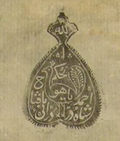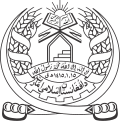| Wazir | Term of office | Shah |
|---|
| Portrait | Epithet
Name
(Birth-Death) | Took office | Left office | Time in office |
|---|
 | Shah Wali Khan شاه والی خان(d. 1772) | 1747 | 1772 | 25 years | Ahmad Shah Durrani 
(1747–1772) |
| Timur Shah Durrani 
(1772–1793) |
 | Hajji Jamal Khan حاجی جمال خان بارکزی
(1719–1772) | 1772 | 1772 | 1 year |
 | Rahimdad Khan رحیمداد خان
(?) | 1772 | 1774 | 2 years |
 | Payandah Khan پاینده خان بارکزی
(1758–1800) | 1774 | 1793 | 19 years |
 | Wafadar Khan وفادار خان(d. 1801) | 1793 | 1801 | 8 years | Zaman Shah Durrani 
(1793–1801) |
| Fateh Khan Barakzai فتح خان بارکزی
(1777–1818) | 1801 | 1803 | 2 years | Mahmud Shah Durrani 
First reign
(1801–1803) |
 | Mukhtar al-Daula مختار الدوله
(d. 1808) | 1803 | 1808 | 5 years | Shah Shuja Durrani 
(1803–1809) |
 | Akram Khan اکرم خان
(d. 1809) | 1808 | 1809 | 1 year |
| Fateh Khan Barakzai فتح خان بارکزی
(1777–1818) | 1809 | 1818 | 9 years | Mahmud Shah Durrani 
Second reign
(1809–1818) |
 | Civil war جنگ داخلی
(1818–1823) | 1818 | 1823 | 5 years | Civil war 
(Civil war) |
 | Mullah Shakar ملا شکر
(?) | 1839 | 1840 | 1 year | Shah Shuja Durrani 
Second reign
(1839–1842) |
 | Mohammad Osman Khan محمد عثمان خان
(1798–1865) | 1840 | 1842 | 2 years |
|












